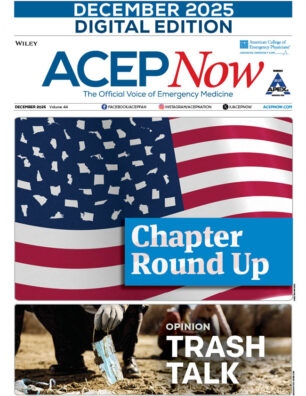The ACEP Clinical Policies Committee regularly reviews guidelines published by other organizations and professional societies. Periodically, new guidelines are identified on topics with relevance to the clinical practice of emergency medicine. This article highlights recommendations for management of a brief resolved unexplained event (BRUE) developed by the American Academy of Pediatrics.1
Working a pediatric shift between a steady stream of upper respiratory infections and gastroenteritis, you encounter a 4-month-old brought in by her parents with a chief complaint of an apparent life-threatening event (ALTE). The parents, appropriately tearful, nervous, and concerned, describe a 30-second episode of their baby going floppy, breathing irregularly, and then recovering back to her normal self. The infant has not had any prior episodes like this, was born full-term, and looks great in your examination. You consider the diagnosis of ALTE. The incidence of ALTE is roughly 0.6 percent to 0.8 percent of all emergency department visits in children younger than 1 year of age, and this diagnosis accounts for about 2.27 percent of pediatric hospitalizations.2 In an effort to improve care for this group of patients, the American Academy of Pediatrics (AAP) developed a guideline with specific recommendations for the workup and management of low-risk pediatric patients with a presentation consistent with ALTE. The objectives of the guideline include replacing the term ALTE with BRUE, outlining an approach to patients presenting with a BRUE, and management recommendations.
The guideline authors provided a definition of a BRUE, which includes length of the episode, the patient being back to baseline normal, there being no other diagnosis to explain it, and the infant having one or more symptoms related to change in status during the episode. If a patient is well appearing and the presentation is consistent with the definition of a BRUE, then a complete history and physical exam must be performed to determine appropriate and negative history and physical exam features. If there is an explanation for the event, then the event is not a BRUE. If there is no clear explanation in a low-risk child, then a BRUE diagnosis can be made.
Once the diagnosis of a BRUE is made, a patient must then be assessed as low- or high-risk for an adverse event or recurrence as well as for symptoms that have a potentially dangerous cause. If there are concerning historical and/or exam features (eg, family history of sudden death, developmental delay, social concerns), then the patient would be categorized as higher-risk and is considered “outside of the guideline scope” for a low-risk BRUE. The AAP guideline provides inclusion criteria for low-risk patients.
For a patient who falls into a low-risk category, the guideline authors developed 29 separate action statements. Each of these action statements were graded with a specific level of evidence quality rating (A, B, C, or D, with A being the highest and D being the lowest rating). An overall strength of the recommendation was provided also (strong, moderate, or weak).
Only one of the action statements was rated as a “strong” recommendation: 4A. Should not obtain a white blood cell count, blood culture, or cerebrospinal fluid analysis or culture to detect an occult bacterial infection (Level B; strong recommendation). Table 51
Some examples of management recommendations particularly pertinent to emergency medicine are that low-risk patients do not have to be admitted solely for continuous monitoring, imaging is not mandatory, and an electrocardiogram is worth considering.
While it would be exhaustive to present every action statement from the guideline, emergency medicine providers should know that this guideline exists and recommends a minimalist workup in the low-risk patient meeting criteria for a BRUE. It cannot be stressed enough that the determination of a low-risk patient by this guideline is based on a very extensive history and physical examination with more than 75 separate historical features and physical examination findings/considerations highlighted in the guideline tables. In patients determined to be a low-risk BRUE, discharge home after minimal or no workup with a detailed, timely follow-up plan and return precautions is a safe and reasonable disposition. Shared decision making should be employed with the family, emergency provider, and primary care provider.
References
- Tieder JS, Bonkowsky JL, Etzel RA, et al; for the Subcommittee on Apparent Life Threatening Events. Brief Resolved Unexplained Events (formerly Apparent Life-Threatening Events) and evaluation of lower-risk infants. Pediatrics. 2016;137(5):e20160590.
- McGovern MC, Smith MB. Causes of apparent life threatening events in infants: a systematic review. Arch Dis Child. 2004;89:1043-1048.
Dr. Ingalsbe is clinical assistant professor of emergency medicine at the University of Nevada, Reno School of Medicine.
Dr. Mace is professor of medicine at the Cleveland Clinic Lerner College of Medicine of Case Western Reserve University and director of research at the Cleveland Clinic in Cleveland, Ohio.
Dr. Valente is associate professor in the departments of emergency medicine and pediatrics at the Alpert Medical School of Brown University, Rhode Island Hospital, and Hasbro Children’s Hospital, all in Providence, Rhode Island.
Pages: 1 2 | Multi-Page





No Responses to “American Academy of Pediatrics Recommendations for Brief Resolved Unexplained Events (Formerly Apparent Life-Threatening Events) and Evaluation of Lower-Risk Infants”